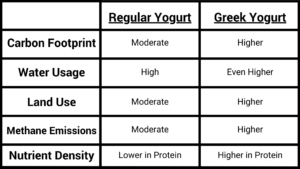Regular Yogurt VS Greek, What’s the Difference?

Sustainability at The Pit: A Yogurt Showdown with a Sweet Twist
Today at The Pit, sustainability was on the menu, and our guests were treated to a fun and educational experience, thanks to Quin, our Sustainability Coordinator, and Isabella, our Dining Sustainability Intern. The pair led a delicious yogurt tasting event aimed at comparing regular yogurt to Greek yogurt—two popular options with distinct environmental impacts.
As guests snacked on Strawberry Frozen Yogurt Bark and indulged in a Frozen Yogurt Mousse made with liquid nitrogen, they were encouraged to spin a wheel that highlighted various environmental factors. The wheel prompted questions about which yogurt had a larger carbon footprint, used more water, required more land, emitted more methane, and had more nutrients. Guests guessed their way through these metrics while learning about the behind-the-scenes production of yogurt.
A New Addition to Deacon Dining
One of the key highlights of today’s event was the recent update to Deacon Dining’s yogurt station. We’re excited to announce that we’ve switched to Stonyfield yogurt, a brand dedicated to sustainability and organic farming practices. Our salad bars will now feature two varieties of regular yogurt—vanilla and strawberry—along with one plain Greek yogurt option.
By incorporating more regular yogurt, we’re reducing waste and lessening the environmental impact of yogurt production—without sacrificing flavor. Additionally, Stonyfield’s USDA Organic certification ensures that its ingredients promote healthy soil, biodiversity, and sustainable farming practices.
Why the Change
How Greek Yogurt Is Made: Greek yogurt is created by straining regular yogurt to remove excess liquid, known as acid whey. This process results in a thicker, creamier texture and tangier flavor. The removal of liquid also concentrates the protein, making Greek yogurt richer in protein and more nutrient-dense than regular yogurt.
The Environmental Cost of Acid Whey: While Greek yogurt has its benefits, it also has a significant environmental downside. Acid whey, the byproduct of straining, can be harmful to aquatic ecosystems and soil if not properly disposed of. In large quantities, it can pollute water sources or make soil too acidic for plant growth. Proper management of acid whey is essential for minimizing its environmental impact.
Resource Usage: Greek yogurt requires approximately 1.5 to 2 times more milk than regular yogurt to produce the same amount of finished product. This increased milk demand leads to a higher consumption of water, land, and energy for dairy farming, giving Greek yogurt a larger environmental footprint.
Environmental and Nutritional Comparison

Greek yogurt’s straining process uses more milk per unit, leading to higher resource usage and environmental impact. Regular yogurt, while not without its own footprint, requires less milk, making it the more sustainable choice in this comparison.
Enjoying Yogurt, the Sustainable Way
As we enjoy the flavors we love, we’re also learning how to make more sustainable choices. By introducing Stonyfield yogurt at our salad bars, Deacon Dining is taking a step toward more responsible sourcing and reducing the environmental impact of yogurt production. Enjoy your next yogurt knowing it’s not just good for you, but for the planet too!